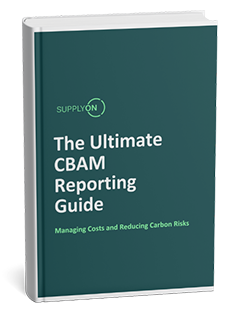Preparing for CBAM 2025: New Requirements and Opportunities for Businesses

The Carbon Border Adjustment Mechanism (CBAM) is a cornerstone of the EU’s strategy to combat climate change by leveling the carbon costs of imported goods with those produced within the EU. This mechanism, which places a carbon price on certain imports, aims to curb “carbon leakage” and promote fairer, climate-conscious trade practices.
As CBAM evolves, 2025 will be the last year of the transitional phase and bring significant updates, including stricter reporting obligations and expanded tools for non-EU operators. This article highlights these upcoming changes and provides practical steps for companies to navigate them.
1. A Look Back at 2024: CBAM’s Initial Rollout
The Pilot Phase
CBAM was launched in 2024, focusing on emission-intensive sectors such as cement, steel, aluminum, fertilizers, and electricity. The initial requirements included emissions tracking and reporting for certain imported products, with a special focus on direct and indirect emissions data.
Challenges and Adjustments
In this first year, many companies faced challenges with emissions data collection and adapting to CBAM’s new framework. Tracking accurate emissions from international suppliers proved difficult for companies without digitalized reporting systems, and understanding the regulatory scope required additional resources.
Lessons Learned from 2024
The rollout underscored the need for accurate data and efficient reporting tools. Businesses recognized the benefits of investing in reliable data management systems to meet compliance requirements, a foundational step as they prepare for the more demanding standards coming in 2025.
2. What’s Changing in CBAM 2025: New Requirements for Businesses
Exclusive Use of the EU Methodology for Emission Calculation
From 1 January 2025, only the EU’s prescribed methodology will be accepted for calculation the embedded emissions of CBAM goods. This requirement aims to standardize emission data and ensure consistency across sectors. Additionally, for complex goods, estimates—including default values—may only be used if they account for less than 20% of the product’s total embedded emissions. Default values, published by the European Commission on 22 December 2023 based on research by the EU’s Joint Research Centre (JRC), will assist in these cases.
New Portal Section in the CBAM Registry for Non-EU Operators
Starting in 2025, a new CBAM Registry portal will support non-EU installation operators in uploading emissions data. This approach means operators won’t need to submit emissions data separately to each declarant, simplifying reporting. It also helps safeguard business-sensitive information. Reporting declarants can then auto-populate their CBAM reports directly from this portal. The exact workings of this system are still being clarified, the EU should publish a delegate act soon.
Application for ‘Authorised CBAM Declarant’ Status
From 2025, CBAM declarants can apply for “authorised CBAM declarant” status via the CBAM Registry. The National Competent Authority in the declarant’s EU Member State will process applications. This status will be mandatory from 2026 for CBAM goods entering the EU customs territory. Applying early can help companies secure compliance and prepare in advance.
Review and Transition Planning for CBAM 2025 and Beyond
Before 2026, the EU will review CBAM’s function during its transitional phase. The review will assess CBAM’s effectiveness and consider expanding its product scope. The EU will publish a report with a phased timeline for product inclusion before 2030.
Global Impact of CBAM
The CBAM has already generated significant attention worldwide. Countries near the EU are expected to implement their own CBAM mechanisms, modeled after the EU’s approach. Finland and the UK are already detailing their plans, while other nations consider carbon pricing schemes to retain carbon revenue that would otherwise go to the EU.
3. CBAM 2025: Impact on Global Supply Chains and Trade Partners
Effects on Non-EU Suppliers
These new requirements will affect non-EU suppliers, especially those with high emissions or limited data transparency. Suppliers may face additional compliance costs to meet EU standards, and companies may need to adjust supply chains to avoid disruptions in goods flow. Businesses importing goods from outside the EU should prepare for these compliance demands and work closely with their suppliers to ensure readiness.
Technology and Compliance Solutions
Meeting the new reporting standards will require accurate, efficient data tracking and reporting. The CBAM Reporting Manager from SupplyOn is one tool designed to streamline compliance for businesses facing CBAM’s complex requirements. This digital platform provides a centralized system for tracking emissions, managing data, and meeting CBAM’s stringent reporting obligations. By using the Reporting Manager, companies can ensure precise emissions data, reduce administrative work, and simplify data sharing with EU reporting authorities. Tools like SupplyOn’s solution can help businesses stay on top of evolving requirements while protecting confidential information in a secure, compliant way.
Integration with ESG Strategies
CBAM compliance is increasingly integrated into Environmental, Social, and Governance (ESG) strategies. By aligning CBAM with broader ESG initiatives, companies can enhance transparency, build investor confidence, and show a proactive commitment to environmental stewardship. A strong ESG strategy, incorporating CBAM reporting, positions companies as climate-conscious leaders in their fields.
Conclusion
The CBAM changes in 2025 will bring new challenges and opportunities for businesses in the EU and beyond. Stricter reporting requirements and advanced digital tools are reshaping compliance standards. As reporting obligations increase, companies need to adapt processes, gather precise emissions data, and streamline operations to meet CBAM standards.
For businesses navigating these new requirements, the CBAM Reporting Manager from SupplyOn is a valuable tool. It helps manage emissions data accurately, ensure compliance, and meet EU reporting standards efficiently. With the right tools and early preparation, companies can meet regulatory demands while gaining a competitive edge in a carbon-conscious market.
Preparing now will help companies navigate CBAM complexities, minimize risks, and position themselves as forward-thinking, responsible leaders. The 2025 changes present an opportunity to reinforce ESG commitments, contribute to global climate objectives, and prepare for the full implementation phase of CBAM.



